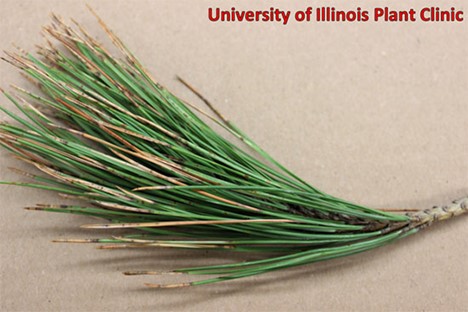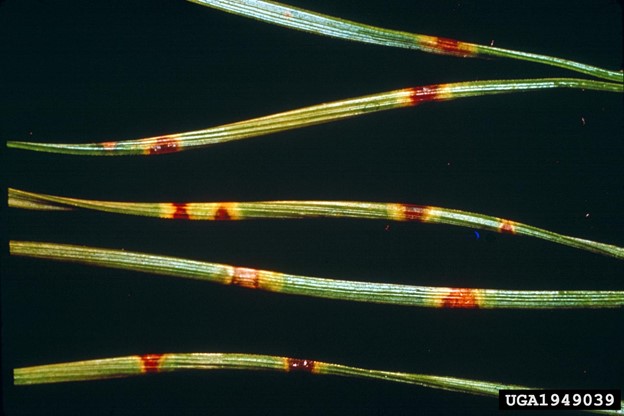Issue 5, June 22, 2022
Dothistroma Needle Blight and Brown Spot of Pine
Dothistroma Needle Blight and Brown Spot are two fungal diseases of pine with nearly identical symptoms. They are caused by different pathogens and tend to appear on different host species. Austrian and ponderosa pines are the most common hosts for Dothistroma needle blight. Scots and red pines are resistant to this disease. Brown spot is mainly a problem on Scots pine, but other pines are also susceptible.
Dothistroma needle blight
Dothistroma needle blight causes spots and bands on needles, especially in the lower part of the tree. The disease is more intense in a monoculture, such as a nursery, but it also occurs in landscaped areas. The first symptoms of Dothistroma needle blight appear in the fall, but often go unnoticed. They appear as yellow to brown bands or individual spots. Laboratory confirmation relies on finding the diagnostic black, pinhead-sized fruiting bodies and spores within the spots. As the disease progresses, needle tips turn brown and fall from the affected needles, leaving green needle bases. Early drop of entire needles is not uncommon, with the period of greatest needle loss from Dothistroma in spring and summer.

Dothistroma needle blight on Austrian pine, University of Illinois Plant Clinic
Dothistroma Needle Blight Management
Cultural controls include practices that promote rapid drying of foliage. Prune surrounding plants, control weeds in the area, and space plants properly. In the home landscape, some control may be attained by removing fallen needles and helping tree vitality through fertilization and watering practices. Copper, copper hydroxide, copper + mancozeb, or copper sulfate sprays can be used, but two sprays are required--one when needles are just emerging in mid-May, and another when new needles are fully expanded. During wet years, additional applications may be necessary for good protection.Brown spot needle blight
Brown spot is mainly a problem on Scots pine. The first symptoms appear in July as yellow spotting of the current-year needles. A small drop of resin can often be seen in association with each spot. The spots turn brown in August and develop into bands, often with a chlorotic halo. Needles die from the tip toward the base, and infected needles drop in the fall and the following spring. Infections are often concentrated on the lower branches and the north side of the tree, where moisture persists. Defoliation gives trees a bare appearance.

Brown spot needle blight on Scots pine, Darroll D. Skilling, USDA Forest Service, Bugwood.org
Brown Spot Needle Blight Management
There are more chemical options for preventing brown spot than for Dothistroma. Applications should be made when needles are half grown and again 30 days later. In rainy conditions, the spray interval may need to be shortened. Home growers can use chlorothalonil (ortho garden disease control), copper octanoate (bonide copper fungicide), and mancozeb (bonide mancozeb flowable with zinc), and propiconazole (bonide infuse systemic Disease Control). Commercial applicators can use products with chlorothalonil, copper octanoate, copper + mancozeb, or mancozeb.
Author:
Travis Cleveland